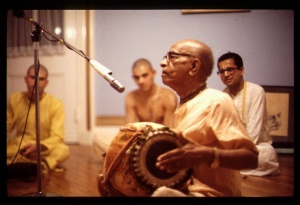CC Madhya 10.46 (1975): Difference between revisions
(Vanibot #0027: CCMirror - Mirror CC's 1996 edition to form a basis for 1975) |
(Vanibot #0020: VersionCompareLinker - added a link to the Version Compare feature) |
||
| Line 2: | Line 2: | ||
<div style="float:left">'''[[Sri Caitanya-caritamrta (1975)|Śrī Caitanya-caritāmṛta (1975)]] - [[CC Madhya (1975)|Madhya-līlā]] - [[CC Madhya 10 (1975)|Chapter 10: The Lord's Return to Jagannātha Purī]]'''</div> | <div style="float:left">'''[[Sri Caitanya-caritamrta (1975)|Śrī Caitanya-caritāmṛta (1975)]] - [[CC Madhya (1975)|Madhya-līlā]] - [[CC Madhya 10 (1975)|Chapter 10: The Lord's Return to Jagannātha Purī]]'''</div> | ||
<div style="float:right">[[File:Go-previous.png|link=CC Madhya 10.45 (1975)|Madhya-līlā 10.45]] '''[[CC Madhya 10.45 (1975)|Madhya-līlā 10.45]] - [[CC Madhya 10.47 (1975)|Madhya-līlā 10.47]]''' [[File:Go-next.png|link=CC Madhya 10.47 (1975)|Madhya-līlā 10.47]]</div> | <div style="float:right">[[File:Go-previous.png|link=CC Madhya 10.45 (1975)|Madhya-līlā 10.45]] '''[[CC Madhya 10.45 (1975)|Madhya-līlā 10.45]] - [[CC Madhya 10.47 (1975)|Madhya-līlā 10.47]]''' [[File:Go-next.png|link=CC Madhya 10.47 (1975)|Madhya-līlā 10.47]]</div> | ||
{{CompareVersions|CC|Madhya 10.46|CC 1975|CC 1996}} | |||
{{RandomImage}} | {{RandomImage}} | ||
==== TEXT 46 ==== | ==== TEXT 46 ==== | ||
| Line 25: | Line 24: | ||
<div class="translation"> | <div class="translation"> | ||
"This is Paramānanda Prahararāja, who is also known as Mahāpātra. He is very, very intelligent. | |||
</div> | </div> | ||
| Line 32: | Line 31: | ||
<div class="purport"> | <div class="purport"> | ||
Prahararāja is a designation given to brāhmaṇas who represent the king when the throne is vacant. In Orissa, between the time of a | Prahararāja is a designation given to brāhmaṇas who represent the king when the throne is vacant. In Orissa, between the time of a king's death and the enthronement of another king, a representative must sit on the throne. This representative is called Prahararāja. The Prahararāja is generally selected from a family of priests close to the king. During the time of Śrī Caitanya Mahāprabhu, the Prahararāja was Paramānanda Prahararāja. | ||
</div> | </div> | ||
Latest revision as of 06:00, 27 January 2020

A.C. Bhaktivedanta Swami Prabhupada
TEXT 46
- prahararāja mahāpātra iṅha mahā-mati
- paramānanda mahāpātra iṅhāra saṁhati
SYNONYMS
prahararāja—Prahararāja; mahāpātra—Mahāpātra; iṅha—this; mahā-mati—very intelligent; paramānanda mahāpātra—Paramānanda Mahāpātra; iṅhāra—of him; saṁhati—combination.
TRANSLATION
"This is Paramānanda Prahararāja, who is also known as Mahāpātra. He is very, very intelligent.
PURPORT
Prahararāja is a designation given to brāhmaṇas who represent the king when the throne is vacant. In Orissa, between the time of a king's death and the enthronement of another king, a representative must sit on the throne. This representative is called Prahararāja. The Prahararāja is generally selected from a family of priests close to the king. During the time of Śrī Caitanya Mahāprabhu, the Prahararāja was Paramānanda Prahararāja.